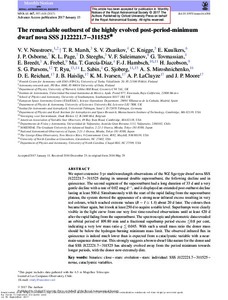The remarkable outburst of the highly evolved post-period-minimum dwarf nova SSS J122221.7-311525
V. V. Neustroev; R. R. Marsh; S. V. Zharikov; C. Knigge; E. Kuulkers; J. P. Osborne; K. L. Page; D. Steeghs; V. F. Suleimanov; G. Tovmassian; E. Breedt; A. Frebel; Ma. T. García-Díaz; F.-J. Hambsch; H. Jacobson; S. G. Parsons; T. Ryu; L. Sabin; G. Sjoberg; A. S. Miroshnichenko; D. E. Reichart; J. B. Haislip; K. M. Ivarsen; A. P. LaCluyze; J. P. Moore
The remarkable outburst of the highly evolved post-period-minimum dwarf nova SSS J122221.7-311525
V. V. Neustroev
R. R. Marsh
S. V. Zharikov
C. Knigge
E. Kuulkers
J. P. Osborne
K. L. Page
D. Steeghs
V. F. Suleimanov
G. Tovmassian
E. Breedt
A. Frebel
Ma. T. García-Díaz
F.-J. Hambsch
H. Jacobson
S. G. Parsons
T. Ryu
L. Sabin
G. Sjoberg
A. S. Miroshnichenko
D. E. Reichart
J. B. Haislip
K. M. Ivarsen
A. P. LaCluyze
J. P. Moore
OXFORD UNIV PRESS
Julkaisun pysyvä osoite on:
https://urn.fi/URN:NBN:fi-fe2021042716811
https://urn.fi/URN:NBN:fi-fe2021042716811
Tiivistelmä
We report extensive 3-yr multiwavelength observations of the WZ Sge-type dwarf nova SSS J122221.7-311525 during its unusual double superoutburst, the following decline and in quiescence. The second segment of the superoutburst had a long duration of 33 d and a very gentle decline with a rate of 0.02 mag d(-1), and it displayed an extended post-outburst decline lasting at least 500 d. Simultaneously with the start of the rapid fading from the superoutburst plateau, the system showed the appearance of a strong near-infrared excess resulting in very red colours, which reached extreme values (B -I similar or equal to 1.4) about 20 d later. The colours then became bluer again, but it took at least 250 d to acquire a stable level. Superhumps were clearly visible in the light curve from our very first time-resolved observations until at least 420 d after the rapid fading from the superoutburst. The spectroscopic and photometric data revealed an orbital period of 109.80 min and a fractional superhump period excess less than or similar to 0.8 per cent, indicating a very low mass ratio q less than or similar to 0.045. With such a small mass ratio the donor mass should be below the hydrogen-burning minimum mass limit. The observed infrared flux in quiescence is indeed much lower than is expected from a cataclysmic variable with a nearmain- sequence donor star. This strongly suggests a brown-dwarf-like nature for the donor and that SSS J122221.7-311525 has already evolved away from the period minimum towards longer periods, with the donor now extremely dim.
Kokoelmat
- Rinnakkaistallenteet [27094]
